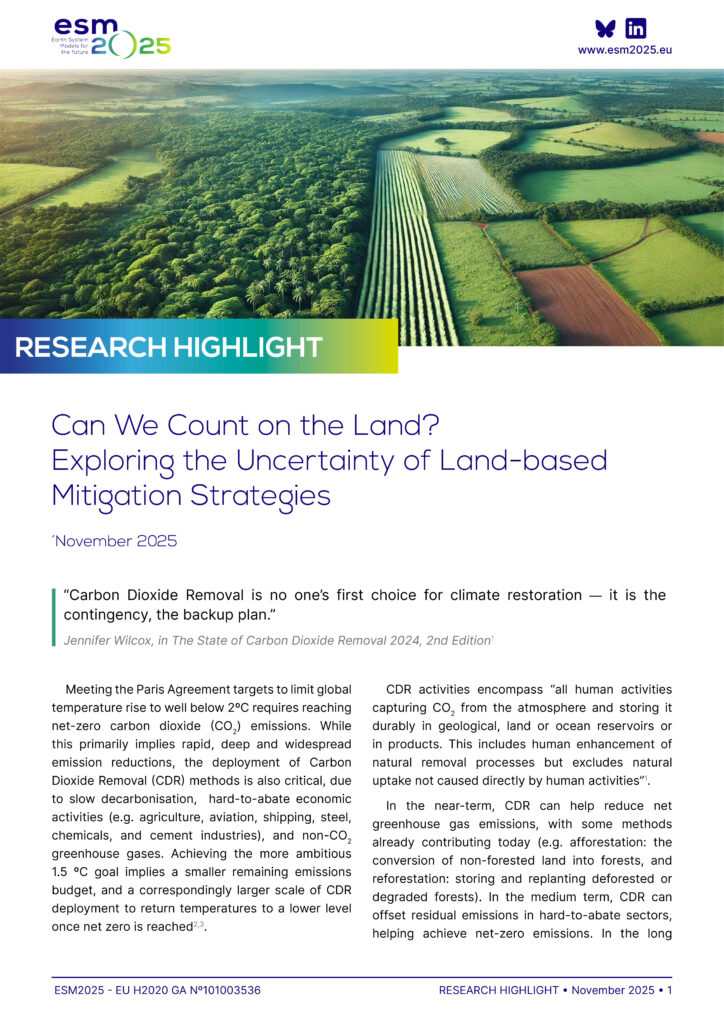
“Carbon Dioxide Removal is no one’s first choice for climate restoration - it is the contingency, the backup plan.”
Jennifer Wilcox, in The State of Carbon Dioxide Removal 2024 - 2nd Edition.
Meeting the Paris Agreement targets to limit global temperature rise to well below 2ºC requires reaching net-zero carbon dioxide (CO2) emissions. While this primarily implies rapid, deep and widespread emission reductions, the deployment of Carbon Dioxide Removal (CDR) methods is also critical, due to slow decarbonisation, hard-to-abate economic activities (e.g., agriculture, aviation, shipping, steel, chemicals, and cement industries), and non-CO2 greenhouse gases. Achieving the more ambitious 1.5ºC goal implies a smaller remaining emissions budget, and a correspondingly larger scale of CDR deployment to return temperatures to a lower level once net zero is reached.2,3
In the near-term, CDR can help reduce net greenhouse gas emissions, with some methods already contributing today (e.g., afforestation: the conversion of non-forested land into forests; and reforestation: storing and replanting deforested or degraded forests). In the medium term, CDR can offset residual emissions in hard-to-abate sectors, helping achieve net-zero emissions. In the long term, CDR can contribute to reaching net-negative emissions, compensating historical emissions and potentially reversing the temperature rise trend.
There is a wide variety of CDR methods, from well established conventional methods already deployed at scale (e.g., afforestation), to novel technologies with low readiness levels, currently operating at small scale or still in the research phase (e.g. artificial photosynthesis ). The way carbon is captured (e.g., biological or geochemical capture processes), the sequestration potential and the durability of storage (from decades to tens of millenia) are also very diverse (see Smith et al. 2024 for a complete overview).
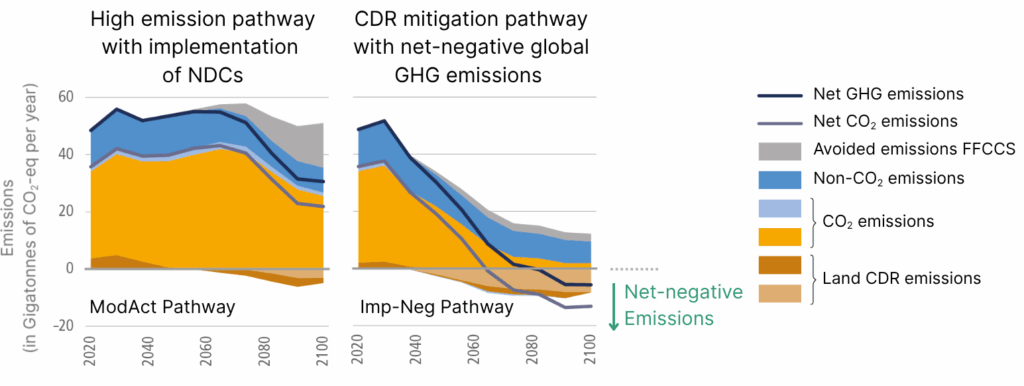
Potential role of land CDR for reaching net-negative emissions. Comparison of two illustrative high-emission and high-mitigation pathways, respectively: the Moderate Action Pathway (ModAct), leading to an increase in global mean temperature of more than 2°C, explores the impact of implementing the Nationally Determined Contributions (NDCs) as formulated in 2020 and some further strengthening after that (including Fossil Fuel Carbon Capture and Storage, FFCCS); and the Illustrative Mitigation Pathway with deployment of carbon dioxide removal that results in net negative global GHG emissions (Imp-Neg), which is consistent with meeting the long-term temperature goals of the Paris Agreement. (Figure adapted from Figure 3.7 WGIII of IPCC AR612).
LAND-BASED CDR
Conventional land-based CDR methods, primarily afforestation and reforestation (AR), account for over 99.9% of all currently deployed carbon dioxide removal. Alongside bioenergy with carbon capture and storage (BECCS), these approaches also remain the most frequently applied in future IPCC assessment scenarios aimed at limiting global temperature rise to 2°C by 2100 2,3,5,6.
Despite their significant carbon removal potential, land-based CDR strategies are subject to persistent uncertainties regarding the permanence of carbon storage and the rates of carbon sequestration. The potential effectiveness of forest-based and bioenergy crop-based sequestration is highly location-dependent, influenced by environmental, climatic, and soil conditions, and subject to change over time. For instance, CO₂ uptake by forests varies with forest age, while BECCS efficiency is tightly linked to the availability and performance of carbon capture and storage infrastructure. Both strategies are also expected to respond differently under future climate and environmental changes.
In addition to these uncertainties, potential side effects of large-scale implementation — such as impacts on local climate, land use, water availability, and ecosystem biodiversity — add further complexity. Extensive land and water use for CDR may create tensions with nature conservation goals or agricultural demands. Moreover, land-based CDR interventions can alter local exposure to climate hazards such as drought, rainfall variability and extremes, heat stress, and compound events, potentially amplifying adaptation needs. These consequences can have serious implications for food security, local livelihoods, and land rights or land use practices, which may therefore result in equally complex social, political and economic constraints on the feasibility of land-based CDR.
"Where risks and side effects are not precluding one method or the other, an important question is which method removes CO2 more efficiently from the atmosphere while optimizing the allocation of financial, and other resources. This question is surprisingly hard to answer.”
Egerer et al. 2024 in Biogeosciences
ASSESSING CLIMATE IMPACTS OF LAND-BASED CDR
Quantifying the true mitigation potential of land-based CDR requires going beyond carbon removal alone.
The complexity of assessing ambitious CDR deployment arises from the fact that both the reductions in atmospheric CO₂ following CDR application and the associated biogeophysical effects (such as altered moisture and surface energy fluxes) can significantly affect the Earth system. Earth system models (ESMs) are powerful tools for capturing these interactions and feedbacks, enabling more reliable estimates of the climate impacts and mitigation potential of CDR. These models simulate the exchange of mass and energy between the land surface, atmosphere, and ocean, allowing investigation of a wide range of climate responses to the different land-based mitigation strategies. This includes not only changes in atmospheric greenhouse gas concentrations, but also shifts in local climate through changes of the surface energy budget, and larger-scale effects on weather and climate patterns through changes in atmospheric circulation or non-GHG components such as water vapor and cloud condensation particles.
However, none of the ESMs contributing to the IPCC’s 6th Assessment Report included specific representation of bioenergy crops, nor did they include comprehensive forest models that simulate age-dependent size and growth, or account for targeted tree planting and forest management practices. As a result, BECCS and AR strategies were not fully or accurately represented in those models. Moreover, different ESMs often produce divergent responses to land-based mitigation, and identifying the causes of model differences is challenging, particularly when models are run under inconsistent (LUC) land-use change scenarios.
Advancing land-based CDR modelling in ESM2025
As part of the ESM2025 project, we used four European Earth System Models (ESMs) (NORESM, MPI-ESM, UKESM, and IPSL) to assess the climate impacts of land-based CDR strategies, specifically afforestation/reforestation and bioenergy with carbon capture and storage. Each of these ESMs incorporates a distinct land surface model: CLM, JSBACH, JULES, and ORCHIDEE, respectively. These land surface models were run with a common set of land-use change scenarios (following ISIMIP offline protocols with an explicit focus on land-use perturbations for mitigation), which enabled a systematic, multi-model comparison of land-based mitigation impacts. The experiments focused on uniform, small-scale conversions of land to bioenergy crops, afforestation, or reforestation. This setup allowed us to isolate and compare the biogeochemical and biophysical responses across models under consistent conditions. A detailed description of this work and results can be found in Harper et al. (in prep).*a,*b
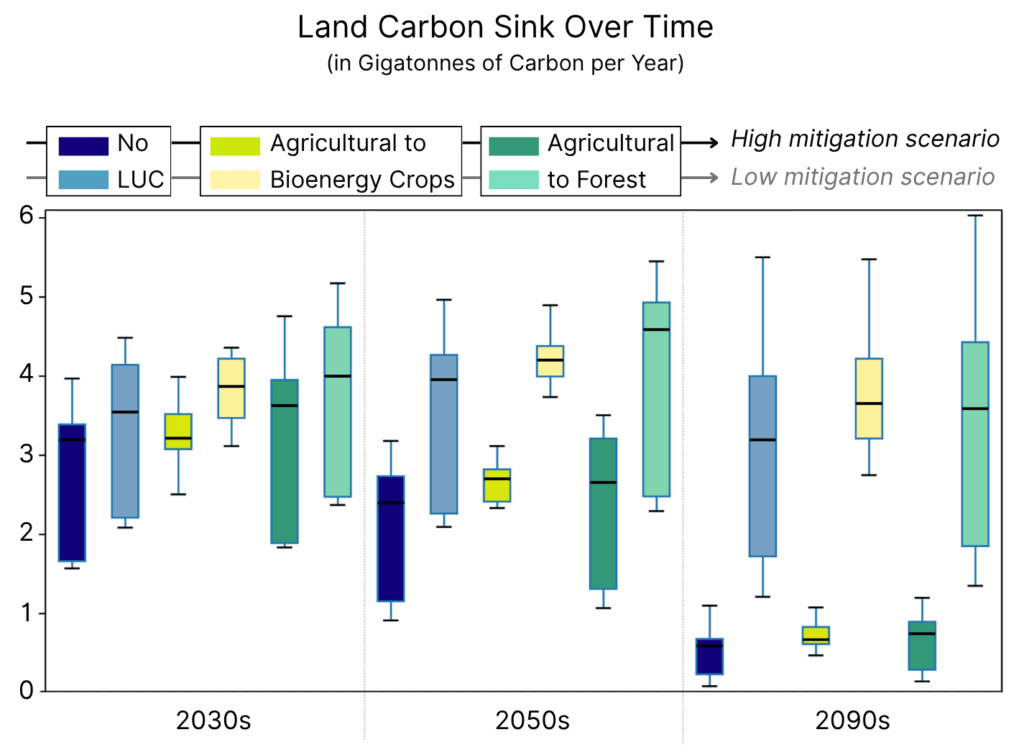
Simulated land carbon sink over time (in the 2030s, the 2050s and the 2090s), with “No LUC”: no land-use change (no land CDR implementation), with “Agricultural to Bioenergy crops” (conversion of agricultural lands to bioenergy crops), and with “Agricultural to Forest” (conversion of agricultural lands to forests); considering both high (SSP1-2.6) and low (SSP3-7.0) mitigation scenarios. Note: The No LUC and “Agricultural to Forest” bars include results from JSBACH, CLM, and ORCHIDEE land surface models; while the “Agricultural to Bioenergy Crops” bars include results from JSBACH and CLM only.
Carbon Cycle Changes
Our model comparisons revealed several important insights into how land-based mitigation strategies affect the carbon cycle, particularly vegetation and soil carbon. While many of these findings are not entirely new to the scientific community, they represent important progress in systematically comparing how different models simulate the impacts of AR and BECCS under harmonised scenarios.
- Without land-use change, forests and soils are expected to continue absorbing carbon. However, in some regions, especially tropical forests, this carbon sink could weaken or even reverse under strong climate mitigation scenarios (for which, after a certain level of climate change, CO2 atmospheric levels stabilise, along with their fertilising effect on vegetation). In the low mitigation scenario, there is substantial uncertainty on the land carbon sink strength by the end of the century.
- Afforestation and reforestation consistently lead to increased carbon storage compared to agricultural land, though their effectiveness declines as global CO₂ levels stabilise and the fertilisation effect weakens.
- Using land for bioenergy crops instead of natural vegetation results in a loss of carbon storage, especially in vegetation. In addition, soil carbon is vulnerable when natural land is converted. Impacts are smaller when bioenergy crops are cultivated on existing farmland. Crucially, converting land can create conflicts with food production and ecosystems.
- The amount of carbon available for long-term storage through BECCS varies widely between models, especially under ambitious mitigation scenarios, which highlights substantial uncertainties.
Beyond Carbon: How AR Changes Local Climate
While carbon removal is the primary goal of land-based CDR, these strategies also trigger significant local climate effects (e.g., in temperature and precipitation) that can amplify or undermine their benefits. Understanding these biogeophysical impacts is crucial for evaluating the full consequences of land-based CDR deployment. Forestation, for example, can influence the local climate via changes in evapotranspiration, surface albedo, and vegetation roughness. These local effects can, in turn, have important socio-economic consequences, given their implications for food production, water availability, and human health.
Under the ESM2025 project, we explored the biogeophysical impacts of forestation using two Earth system models: MPI-ESM and UKESM. Key findings include:
- Surface temperature effects of new forests vary by region: Both models showed opposite signs of temperature change across latitudes — cooling in tropical and mid-latitude regions, but warming in high latitudes. The approximate transition line lies around the US–Canada border and between Northern and Central Europe. These patterns highlight the need for regionally differentiated assessments of land-use change impacts on mitigation and adaptation.
- Climate benefits or trade-offs vary by region: In tropical and temperate zones, afforestation and reforestation offer a dual benefit, helping mitigate climate change through CO₂ removal while also contributing to local cooling. In high-latitude regions, however, trade-offs arise: forestation may reduce atmospheric CO₂ but lead to local warming, requiring more careful evaluation of mitigation–adaptation synergies.
- Precipitation generally increases with forestation, though the magnitude varies between regions and models. Simulations confirm that land-use and land-cover changes can substantially alter local hydrological patterns.
To further assess implications for agriculture and hydrology, we linked the ESM outputs to LPJmL, a dynamic global vegetation and hydrology model. This allowed us to estimate potential impacts on key socioeconomic and biogeochemical variables:
- Agricultural yields tend to increase slightly with greater forest cover. Overall effects are modest (within ±10%), but spatial patterns and the direction of change vary significantly between models, indicating low model agreement.
- Runoff generally increases with forest expansion, following changes in precipitation. The strength of this response differs by model and region.
- Carbon stocks in boreal regions decrease with increasing forest cover, suggesting trade-offs between biogeophysical and biogeochemical responses in high-latitude ecosystems.
Substantial discrepancies in the magnitude and spatial distribution of impacts across the two models point to considerable uncertainty between models in how forest cover changes influence local climate. Still, the scale of the estimated effects, particularly on runoff and carbon stocks, is large enough to be relevant for socioeconomic and broader assessments of land-based mitigation strategies. This highlights the need for continued development of how land-based CDR strategies are represented in models.
THE SOCIO-ECONOMIC DIMENSION OF LAND-BASED CDR
Integrated Assessment Models (IAMs) play a central role in evaluating how land-based carbon removal strategies interact with broader socio-economic systems. Building on inputs from Earth System Models (such as carbon sequestration potential, local climate impacts, and biogeophysical feedbacks of the different CDR strategies), IAMs can quantify trade-offs, estimate resource requirement (e.g., land and bioenergy), and generate carbon price trajectories compatible with climate goals.
Although our results showed that land-based CDR (particularly forest-cover changes) has substantial impacts on runoff and carbon stocks — effects that could meaningfully influence IAM outcomes — incorporating these effects into the IAM framework proved to be highly challenging. In the process of exploring ways to integrate carbon stock dynamics into the modelling framework, a case of scientific serendipity emerged, giving rise to an entirely new line of research that had not been previously explored.
The Overlooked Importance of Carbon Stock Uncertainty
In ESM2025, we carried out, for the first time, a systematic comparison of how different ESMs simulate land-based CDR measures across a range of scenarios. When these results were shared with the IAM community, it became evident that different ESMs were providing land-related data in highly diverse formats and with significant variation in key variables. This exposed a critical communication gap: Earth system models and economic models speak different “carbon languages.”
The problem is simple but profound:
- ESMs report how carbon stocks change over time (i.e., carbon fluxes) and report the values aggregated over a grid cell (not the land-use type values needed by IAMs).
- IAMs need to know how much carbon can be stored in different land types (i.e., per-area carbon values for different land-use types) to estimate land-use change emissions and project mitigation potential.
This gap in terminology and methodology has important implications. IAMs depend heavily on carbon density assumptions, yet these are often highly uncertain and poorly constrained. Our findings showed that land-use change emissions estimates are extremely sensitive to these assumptions, and that the diversity of ESM inputs further amplifies this uncertainty. While climate mitigation assessments often focus on uncertainties in the climate system (e.g., climate sensitivity or non-CO₂ forcings), uncertainties in the land carbon cycle, especially in current carbon stock densities, remain underexplored. Yet these overlooked uncertainties play a decisive role in shaping the costs and feasibility of land-based mitigation.
Our analysis (in Abrahão et al., in prep*c.) suggests that uncertainties in current carbon stocks are even larger than those related to how these stocks may respond to future climate change. Although scientific attention often focuses on uncertainties in the response of carbon fluxes to environmental changes, the viability and effectiveness of land-based CDR, particularly afforestation and reforestation, depend more directly on the absolute amount of carbon that can be stored in vegetation and soils. These findings have major implications for how IAMs assess mitigation strategies and allocate land-use priorities. They also support a broader conclusion: physical uncertainties in the land carbon cycle, especially those related to stocks and their response to land-use change, can significantly influence mitigation pathways.
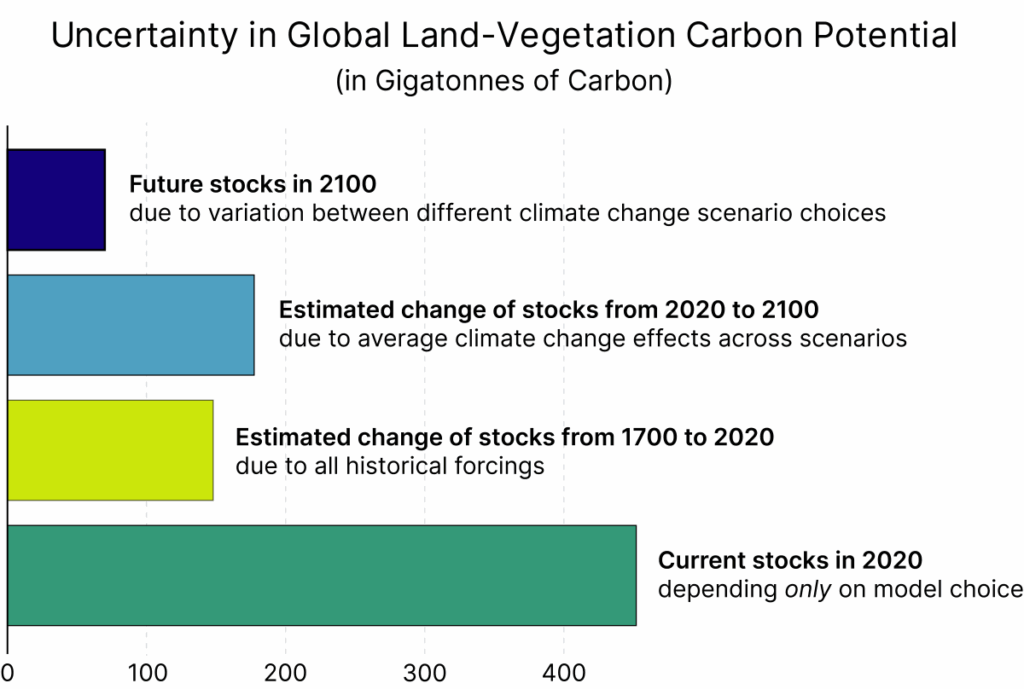
Comparison of the uncertainty in global land-vegentation carbon potentials for, from top to bottom, (i) the carbon potentials in 2100, depending on the climate change scenario choice (considering the different Representative Concentration Pathways, RCPs, of IPCC AR6); (ii) the mean estimated change in carbon potentials due to climate change between 2020 and 2100 (across all RCPs); (iii) the mean estimated historical change in carbon potentials between 1700 and 2020, using TRENDY Dynamic Global Vegetation Models, DGVMs (it does not include direct land-use change); and (iv) the 2020 carbon potentials depending on the TRENDY DGVM used to calculate those potentials. Note: The global land-vegetation carbon potential denotes the estimated carbon density that would have existed without human interference since 1700, assuming each vegetation type developed in its naturally occurring habitat.
The Risks of Relying on Land-Based Mitigation
Assumptions about the land carbon cycle — particularly carbon stocks — play a critical role in shaping the design, feasibility, and costs of future mitigation pathways in IAMs. Our findings show that even modest variations within the current uncertainty range of carbon stock densities lead to substantially different estimates of land-use change emissions and shift the optimal deployment of mitigation strategies. In the scenarios assessed in this work, these differences translate into cumulative land-use change emissions ranging from slightly net-negative to as high as +60 GtCO₂ by 2050: a spread large enough to materially affect global carbon budgets.
These divergent emissions trajectories also carry significant economic consequences. In Paris-compatible pathways, the estimated carbon price required to achieve net-zero by mid-century can vary dramatically depending on land carbon assumptions, from around 450 to over 600 USD per tonne of CO₂. Notably, these variations arise solely from plausible assumptions within the current uncertainty range of land carbon stocks.
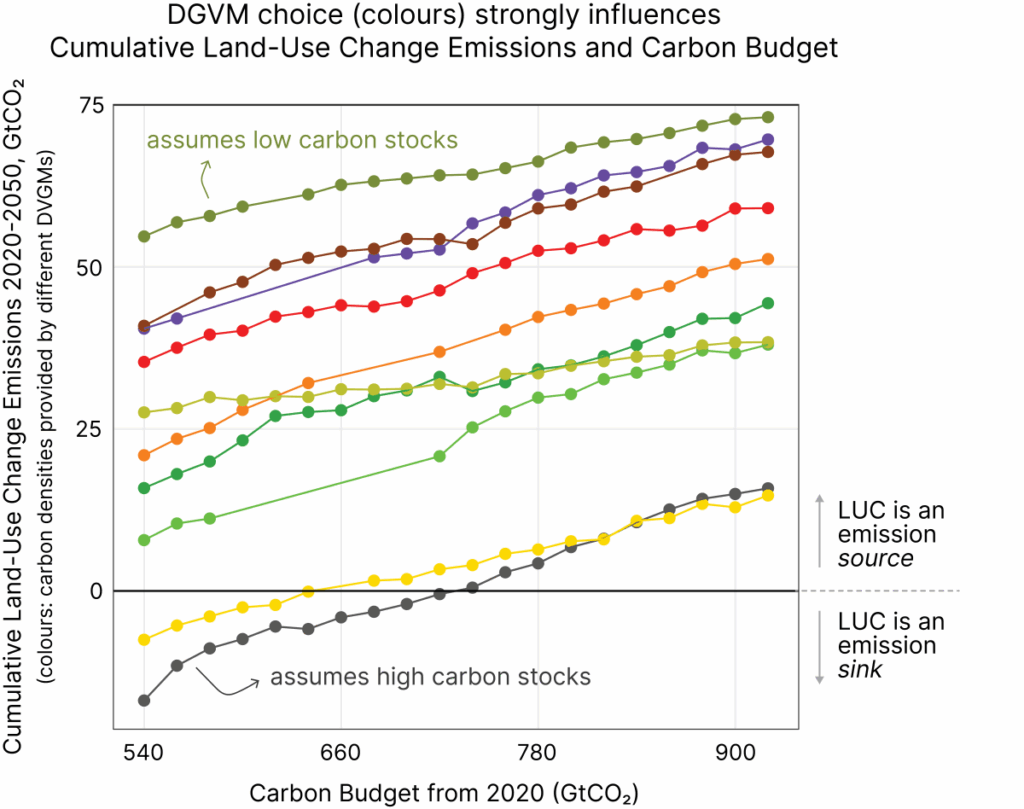
DGVM choice strongly influences cumulative land-use change emissions from 2020. Each colour represents the cumulative LUC emissions 2020-2050 in scenarios that keep total CO2 emissions under a range of carbon budgets from 2020, based on the carbon density values provided by each of the 10 different DGVMs considered. Depending on the DGVM considered, LUC can be either a large emission source or a weak sink, even for very stringent carbon budgets.
Moreover, while uncertainties in how the land responds to climate change — including feedbacks involving drought, temperature, pests, or tipping points — may be comparatively smaller than those of the baseline carbon stocks, they remain significant and poorly understood. These “known unknowns” compound the risks associated with overreliance on land-based mitigation. Land-based strategies such as afforestation are particularly sensitive, as their effectiveness depends not only on future environmental conditions, but also on the uncertain magnitude of existing carbon stored in vegetation and soils.
This leads to a broader warning: betting on a strong land sink is inherently risky, even if current stocks were to remain stable over time. If, as is plausible, climate impacts degrade the strength of the land sink over coming decades, mitigation pathways that depend heavily on land-based options could prove infeasible or require abrupt and costly course corrections. As one researcher aptly put it:
"That is a really risky bet — land is more part of the problem than of the solution."
In addition, mitigation via afforestation and reforestation becomes progressively less effective as we approach net-zero, due to the declining CO₂ fertilisation effect and saturation limits on additional carbon sequestration.
Furthermore, potential correlations between the land carbon sink (“land stream” of the ESM-IAM modelling framework) and the climate system (“climate stream”) mean that these risks are not independent but may reinforce one another — making land-based mitigation a potentially fragile pillar of climate strategy. Assuming that land-based options alone can reliably deliver on Paris Agreement temperature targets is unwise without a better understanding, and reduction, of underlying uncertainties.
Addressing these challenges requires sustained collaboration between the IAM, mitigation modelling and biophysical land modelling communities. Only through the integration of improved observational constraints, standardised carbon stock data, and harmonised modelling approaches can we ensure that land-based mitigation strategies are reliable, effective, and resilient components of long-term climate policy.
KEY TAKEAWAYS AND NEXT STEPS
This research represents a significant advance in our understanding of how land-based carbon dioxide removal strategies interact with the Earth system and their potential socio-economic impacts. A major strength of ESM2025 was its consistent use of up to four different land models per scenario, leveraging model diversity to explore how structural differences affect outcomes. This multimodel setup, rarely applied so systematically to land-based mitigation, provided new insights into carbon stock uncertainties, marking one of the projectʼs most innovative contributions.
While not originally framed as a core objective, the structured comparison of mitigation-specific land-use developments enabled, for the first time, a direct, policy-relevant assessment of these strategies. For the Integrated Assessment modelling community, this created new opportunities to evaluate land-based mitigation in a more consistent and comparable way.
The project also underscored the challenges of bridging communities that have traditionally worked in parallel. Coordinating researchers from different institutions and modelling cultures within a shared ESM2025 Work Package required overcoming differences in priorities, terminology, and methods. Technical obstacles also emerged as models evolved during the project, requiring careful decisions about versioning and model readiness.
Although ESM2025 did not bring about revolutionary advances in land surface model design, it delivered the first systematic estimates of land-based mitigation impacts using offline land models. These results are not only valuable in their own right: they also serve as foundational inputs for the next generation of coupled Earth system and integrated assessment models.
Still, much remains to be done. In many ways, this work only begins to scratch the surface of what is needed to robustly evaluate land-based CDR. The persistent physical uncertainties around carbon stocks, the disconnects between ESM and IAM outputs, and the policy relevance of local biogeophysical effects all point to the need for deeper and ongoing collaboration. Looking ahead, this work has laid the groundwork for land-based enquiries in a dedicated Carbon Dioxide Removal Model Intercomparison Project (CDR-MIP) in the next round of global MIPs. In addition, a coordinated effort, linking ESMs, IAMs, and land-use scenario protocols, would represent a logical and necessary next step. Only through such integrated efforts can land-based strategies become not just hopeful solutions, but robust and resilient pillars of long-term climate action.
*aHarper, A.B., Littleton, E.W., Egerer, S., Nützel, T., Fisher, R., Aas, K., Abrahoe, G., Sanderson, B., Pongratz, J. Impacts of bioenergy crops on the carbon cycle and surface energy budget in current generation land surface models (in preparation).
*bHarper, A.B., Littleton, E.W., Egerer, S., Nützel, T., Fisher, R., Aas, K., Peylin, P., Bastrikov, V., Miller, A.M., Townsend, B., Abrahoe, G., Sanderson, B., Pongratz, J. Land carbon sink response to future climate change, afforestation, and reforestation, and implications for relying on the land for climate mitigation (in preparation).
*cAbrahão, G., Heinke, J., Crawford, M., Steibert, N., Kriegler, E., Rogelj, J., Kalidindi, S., Bauer, N., Strefler, J., Dietrich, J. P., Humpenöder, F., Klein, D., Mueller, C., Karstens, K., Popp, A., Harper, A., Aas, K., Fisher, R., Lewis, J., Nicholls, Z.; Carbon cycle uncertainties and the role of the land in ambitious mitigation pathways (in preparation).
Authors: Mariana Rocha (CNRM/Météo-France), Anna Harper (University of Georgia, USA; University of Exeter, UK) Gabriel Abrahão (PIK, Germany), and Rosie Fisher (CICERO, Norway).
Other ESM2025 researchers working on this topic: Emma Littleton (University of Exeter), Kjetil Aas (CICERO), Arthus Argles and Eddy Robertson (UK MetOffice), Jens Heinke, Michael Crawford, Elmar Kriegler (PIK), Sirisha Kalidindi and Joeri Rogelj (Imperial College), Gang Tang (University of Melbourne).

